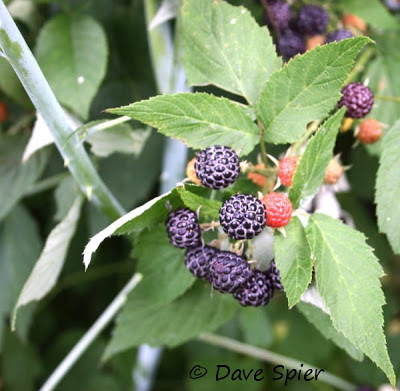Beware of tall, attractive wildflowers with prickly leaves growing in fields. Most have beautiful magenta or lavender-colored heads, but the leaves, and sometimes the stems, are edged with numerous, sharp spines to defend against herbivores looking for an easy meal. These are the thistles. They are composites, related to daisies and goldenrods in spite of the obvious differences. Most are biennials, starting as a ground-hugging rosette of prickly leaves the first year, then growing tall and flowering the second.
The Canada Thistle (Cirsium arvense), a misnamed alien invasive from Europe, is one of the less-obvious species here [in the northern Finger Lakes region of NY] because its light-purple heads are less than an inch high. The whole plant grows four to five-plus feet high and often forms dense colonies after spreading by underground stems. In Europe and northern Asia, it is known as Creeping Thistle. One plant's roots can spread to a three-foot diameter (or more) in one year and continue growing at this rate for many years, making it a difficult plant to eradicate. A single thistle plant can be considered biennial, but the root system is perennial and continues to put its energy into new clonal [cloned] shoots.
 |
| Canada Thistles form colonies from a spreading underground root system. Less energy goes into producing flowers. |
Canada Thistle's main stems are smooth, but the deeply-lobed leaves are designed to keep you at a distance. In the spring, wear heavy gloves and protective clothing so you can return to the location and collect the young leaves, young stems and roots for food. One of the plant's nicknames is "lettuce from hell" (and it actually is related to lettuce). After removing the spines, add young leaves to salads or eat them cooked. The pithy, young stems are easier to deal with; just peel and eat raw or cooked. The roots of first year plants, before the tall stems begin, are a survival food, but they also can cause flatulence.
 |
| A crab spider is camouflaged against a Canada Thistle flower bud. |
Canada Thistle is also food for wildlife, especially goldfinches and other finches that eat the seeds. Some butterfly and moth larvae eat the leaves. Look for Red Admirals, Viceroys and Painted Ladies on this thistle. The larvae of the Orellia ruficauda fruit fly parasitize the fertile seed heads, making them a somewhat-effective biological control.
In the past, a tea made from the leaves was used as a general tonic (stimulant) and diuretic to increase the loss of water from the body. Externally, it was used for skin sores and poison-ivy rash. Native Americans used a root tea as a digestive tract stimulant and dewormer. (I wonder what they used before Europeans introduced this wildflower.) At the other extreme, it was said to cause inflammation and irritation (Jacobs and Burlage). Go figure.
Cirsium comes from the Greek word, kirsion, from kirsos, a "swollen vein" remedied by one of the species in that genus. The species name, arvense, is Latin for "in the field." Among its other common names are "field thistle," "perennial thistle" and "cursed thistle." It was originally native to the Mediterranean and southeast Europe and likely arrived in North America during the 1600's.
Corrections, comments and questions are always welcome at northeastnaturalist@yahoo.com or connect through my Facebook page and photo page. There's also a community-type page for The Northeast Naturalist. Other nature and geology topics can be found on the parallel blogs Adirondack Naturalist and Heading Out.











